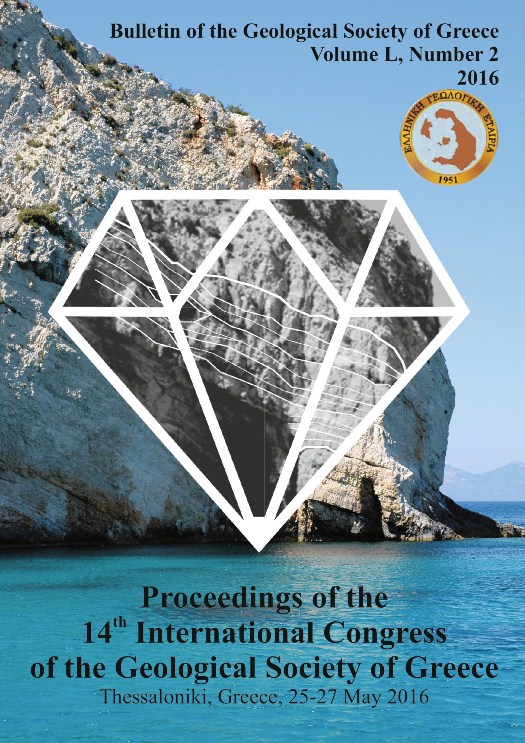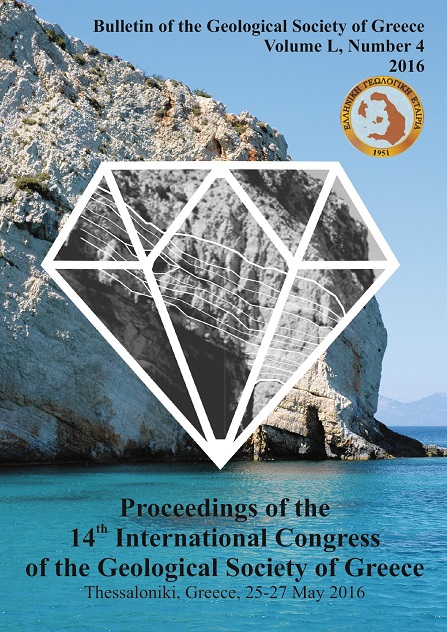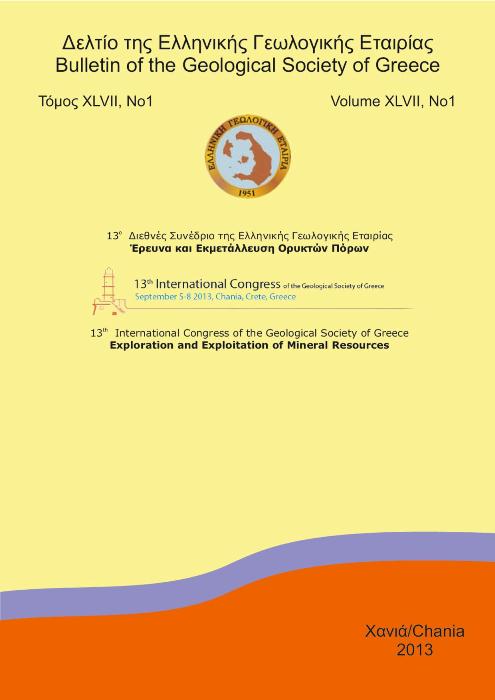HYDROCHEMICAL STUDY OF THE HOT GROUNDWATER OF AMPELIA AREA, EASTERN THESSALY, GREECE. A NEW AREA WITH GEOTHERMAL INTEREST

Περίληψη
Η περιοχή της Αμπελίας είναι μια νέο-ανακαλυφθείσα περιοχή, η οποία παρουσιάζει γεωθερμικό ενδιαφέρον, χωρίς να παρουσιάσει επιφανειακές γεωθερμικές εκδηλώσεις. Εντοπίζεται στη λεκάνη των Φαρσάλων και ανήκει στο τεκτονικό βύθισμα του Ενιπέα. Η γεωθερμική ανωμαλία συνδέεται με τα ρήματα διεύθυνσης Α-Δ, που ελέγχουν την δημιουργία της κοιλάδας και τα διασταυρούμενα σε αυτά ρήγματα διεύθυνσης ΒΒΔ-ΝΝΑ. Οι θερμοκρασίες από τις βαθιές γεωτρήσεις (> 200 μ) κυμαίνονται από 20 έως 41oC. Η χημική σύσταση των δειγμάτων παρουσιάζει έντονες διαφοροποιήσεις. Τα περισσότερα δείγματα έχουν επηρεαστεί από κρύους επιφανειακούς υδροφόρους (υψηλές τιμές E.C. και NO3-). Τα πιο αντιπροσωπευτικά δείγματα με T > 30oC προέρχονται από βαθιές γεωτρήσεις που αναπτύσσονται και μέσα στο τεκτονισμένο κρυσταλλικό υπόβαθρο (ασβεστόλιθοι, φλύσχης, οφιολιθικά πετρώματα). Τα δείγματα αυτά παρουσιάζουν τις υψηλότερες τιμές pH (pH > 8) και τις χαμηλότερες τιμές E.C. Επίσης, παρουσιάζουν πολύ χαμηλές συγκεντρώσεις Ni και Cr, ενδεικτικό ότι δεν είναι σε επαφή με τα υπερβασικά πετρώματα των οφιολιθικών σχηματισμών. Βασιζόμενοι σε πυριτικά χημικά γεωθερμόμετρα και εστιάζοντας κυρίως στις τιμές των πιο αντιπροσωπευτικών δειγμάτων εκτιμάται ότι η θερμοκρασία ενός πιθανού γεωθερμικού ταμιευτήρα στην περιοχή πρέπει να κυμαίνεται από ~ 60 έως 100oC.
Λεπτομέρειες άρθρου
- Πώς να δημιουργήσετε Αναφορές
-
Kanellopoulos, C., Christopoulou, M., Vakalopoulos, P., Efthimiopoulos, T., & Xenakis, M. (2016). HYDROCHEMICAL STUDY OF THE HOT GROUNDWATER OF AMPELIA AREA, EASTERN THESSALY, GREECE. A NEW AREA WITH GEOTHERMAL INTEREST. Δελτίο της Ελληνικής Γεωλογικής Εταιρείας, 50(2), 710–719. https://doi.org/10.12681/bgsg.11777
- Ενότητα
- Engineering Geology, Hydrogeology, Urban Geology

Αυτή η εργασία είναι αδειοδοτημένη υπό το CC Αναφορά Δημιουργού – Μη Εμπορική Χρήση 4.0.
Οι συγγραφείς θα πρέπει να είναι σύμφωνοι με τα παρακάτω: Οι συγγραφείς των άρθρων που δημοσιεύονται στο περιοδικό διατηρούν τα δικαιώματα πνευματικής ιδιοκτησίας επί των άρθρων τους, δίνοντας στο περιοδικό το δικαίωμα της πρώτης δημοσίευσης. Άρθρα που δημοσιεύονται στο περιοδικό διατίθενται με άδεια Creative Commons 4.0 Non Commercial και σύμφωνα με την οποία μπορούν να χρησιμοποιούνται ελεύθερα, με αναφορά στο/στη συγγραφέα και στην πρώτη δημοσίευση για μη κερδοσκοπικούς σκοπούς. Οι συγγραφείς μπορούν να: Μοιραστούν — αντιγράψουν και αναδιανέμουν το υλικό με κάθε μέσο και τρόπο, Προσαρμόσουν — αναμείξουν, τροποποιήσουν και δημιουργήσουν πάνω στο υλικό.





